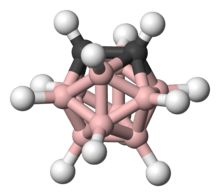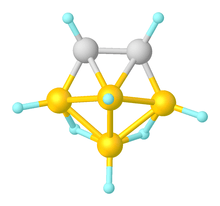Carborane
Carboranes are electron-delocalized (non-classically bonded) clusters composed of boron, carbon and hydrogen atoms that may also contain other metallic and nonmetallic elements in the cluster framework.[1] Like many of the related boron hydrides, these clusters are polyhedra or fragments of polyhedra, and are similarly classified as closo-, nido-, arachno-, hypho-, etc. based on whether they represent a complete (closo-) polyhedron, or a polyhedron that is missing one (nido-), two (arachno-), three (hypho-), or more vertices. Carboranes are a notable example of heteroboranes.

Carboranes have as few as 5 and as many as 14 atoms in the cage framework (15 if metal atoms are included) are known, but the majority have two cage carbon atoms; of these, the best-known series is that of the closo-C2BnHn+2 systems where n = 3 to 12. However, carboranes having 1 to 6 cage carbon atoms have been prepared, as have a number of carborane mono- and dianions. The icosahedral CB11H12− anion is a strong acid, and its polychlorinated derivative H(CHB11Cl11) is a superacid.
The icosahedral charge-neutral closo-carboranes, 1,2-, 1,7-, and 1,12-C2B10H12 (respectively ortho-, meta-, and para-carborane in the informal nomenclature) are particularly stable and are commercially available.[2] These boron-rich clusters exhibit unique organomimetic properties with chemical reactivity matching classical organic molecules, yet are structurally similar to metal-based inorganic and organometallic species[3]
The C2B10H12 isomers, together with other carborane clusters and metallacarboranes (see below) are utilized in a wide range of applications including heat-resistant polymers, recovery of radioactive metals from nuclear waste, catalysis, novel electroactive materials, and medical applications. Like other electron-delocalized polyhedral clusters, the electronic structure of these cluster compounds can be described by the Wade–Mingos rules.[4]
As noted above, carboranes are closely related to boron hydrides (boranes), and thus are structurally very different from hydrocarbons, owing to the fact that carbon atoms have one more valence electron than do boron atoms (a notable feature of carboranes is that the cage carbon atoms often are directly bound to as many as 6, or even more, neighboring atoms, quite unlike the hydrocarbons). Carboranes and boranes adopt 3-dimensional cage (cluster) geometries in order to facilitate their electron-delocalized nonclassical bonding, whereas hydrocarbons are typically chains or rings; for example, B4H10 has an arachno cage geometry while the butane isomers n- and iso-C4H10, with 4 more electrons than B4H10, adopt linear or branched chain structures. Examples of nido and arachno- carboranes include 2,3-C2B4H8 and 1,3-C2B7H13, respectively. Geometrical isomers of carboranes can exist, necessitating the use of the numerical prefixes in a compound's name; this is illustrated by the 1,2-, 1,7-, and 1,2-C2B10H12 icosahedral clusters referred to earlier.[note 1][note 2][note 3]
Preparation
Carboranes have been prepared by many different routes, the most common being addition of alkynyl reagents to boron hydride clusters to form dicarbon carboranes. For example, the high-temperature reaction of pentaborane(9) with acetylene affords several closo-carboranes as well as other products:
- nido-B5H9 + C2H2 closo-1,5-C2B3H5, closo-1,6-C2B4H6, 2,4-C2B5H7
When the reaction is conducted at lower temperatures, an open-cage carborane is obtained:
- nido-B5H9 + C2H2 nido-2,4-C2B4H8
Other procedures generate carboranes containing three or four cage carbon atoms (refs. [1],[4],[5])
Monocarba derivatives
Monocarboranes are clusters with BnC cages. The 12-vertex derivative is best studied, but several are known.
Typically they are prepared by the addition of one-carbon reagents to boron hydride clusters. One-carbon reagents include cyanide, isocyanides, and formaldehyde. For example, monocarbadodecaborate ([CB11H12]−) is produced from decaborane and formaldehyde, followed by addition of borane dimethylsulfide.[8][9]
Dicarba clusters
Dicarbaboranes can be prepared from boron hydrides using alkynes as the source of the two carbon centers. In addition to the closo-C2BnHn+2 series mentioned above, several open-cage dicarbon species are known including nido-C2B3H7 (isostructural and isoelectronic with B5H9) and arachno-C2B7H13.

Syntheses of icosahedral closo-dicarbadodecaborane derivatives (R2C2B10H10) employ alkynes as the R2C2 source and decaborane (B10H14) to supply the B10 unit.
Tricarba, tetracarba, pentacarba, and hexacarba clusters
Carboranes having more than two carbon atoms in the skeletal framework, obtained in a variety of ways, include derivatives of nido-C3B3H7, nido-C3B8H11, nido-C4B2H6, nido-C4B4H8, nido-C5BH6+, and arachno-H6C6B6Et6 (reference [1]).
Isomerism
Many dicarbaboranes exist as isomers that differ in the relative location of the carbon centers. In addition to the three previously mentioned icosahedral C2B10H12 compounds, isomerism is also found in some smaller closo-carborane systems, e.g., 1,2- and 1,6-C2B4H6, 2,3- and 2,4-C2B5H7, 1,2- and 1,6-C2B6H8, and 2,3- and 2,4-C2B5H7, as well as in open-cage carboranes such as 2,3- and 2,4-C2B4H8 and 1,2 and 1,3-C2B9H13.
In general, isomers having non-adjacent cage carbon atoms are more thermally stable than those with adjacent carbons, so that heating tends to induce mutual separation of the carbon atoms in the framework. This is illustrated by the thermal isomerization of 1,2- to 1,6-C2B4H6 and of 1,2- to 1,7-C2B10H12. Formation of the 1,12-C2B10H12 (para-carborane) isomer requires much higher temperatures (ca. 600C), accompanied by some decomposition (refs. [1], [4], and [5]).
Reactions
Carboranes undergo a wide variety of reactions. Deprotonation of closo-dicarbadodecaboranes using organolithium reagents gives the dilithio derivatives.[11]
- C2B10H12 + 2 BuLi → Li2C2B10H10 + 2 BuH
These dilithiated compounds react with a variety of electrophiles, e.g. chlorophosphines, chlorosilanes, and sulfur.[12]
Base-induced degradation of carboranes give anionic nido derivatives, which can be employed as ligands for transition metals, generating metallacarboranes, which are carboranes containing one or more transition metal or main group metal atoms in the cage framework, discovered in 1965.[13] The bulk of the work on metallacarboranes has centered on 12-vertex MC2B9 and M2C2B8 clusters and 7-vertex MC2B4 and M2C2B3 (triple-decker[14] and multidecker sandwich[15]) clusters, but metallacarboranes of 6 to 15 vertices have also been prepared,[16] as have clusters with varying numbers of carbon, boron, and metal atoms (see refs. [1], [4[, and [5]). Diborolyl-metal complexes featuring MC3B2 and M2C3B2 cages, representing another type of metallacarborane, have also been extensively studied [17]
Research
Dicarbollide complexes have been evaluated for many applications for many years, but commercial applications are rare. The bis(dicarbollide) [Co(C2B9H11)2]− has been used as a precipitant for removal of 137Cs+ from radiowastes.[18]
The medical applications of carboranes have been explored.[19][20] C-functionalized carboranes represent a source of boron for boron neutron capture therapy.[21]
Some metal complexes exhibit catalytic properties.[22]
The compound H(CHB11Cl11) is a superacid, forming an isolable salt with protonated benzene, C6H+
7.[23] It protonates fullerene, C60.[24]
See also
Notes
- For general overviews of carborane chemistry see "Chemistry of the Elements", pp. 181–189[5] and "Advanced Inorganic Chemistry, Sixth Edition, pp. 131-174".[6]
- A recent comprehensive treatment of this area, with references updated annually, can be found in Carboranes 3rd Ed.[1]
- Electron-delocalized bonding in boranes and carboranes is discussed extensively in Boron Hydrides[7]
References
- Grimes, R. N., Carboranes 3rd Ed., Elsevier, Amsterdam and New York (2016) ISBN 9780128018941
- Jemmis, E. D. (1982). "Overlap control and stability of polyhedral molecules. Closo-Carboranes". Journal of the American Chemical Society. 104 (25): 7017–7020. doi:10.1021/ja00389a021.
- Spokoyny, A. M. (2013). "New ligand platforms featuring boron-rich clusters as organomimetic substituents". Pure and Applied Chemistry. 85 (5): 903–919. doi:10.1351/PAC-CON-13-01-13. PMC 3845684. PMID 24311823.
- The Wade–Mingos rules were first stated by Kenneth Wade in 1971 and expanded by Michael Mingos in 1972:
* Wade, Kenneth (1971). "The structural significance of the number of skeletal bonding electron-pairs in carboranes, the higher boranes and borane anions, and various transition-metal carbonyl cluster compounds". J. Chem. Soc. D. 1971: 792–793. doi:10.1039/C29710000792.
* Mingos, D. M. P. (1972). "A general theory for cluster and ring compounds of the main group and transition elements". Nature Physical Science. 236: 99–102. doi:10.1038/physci236099a0.
They are sometimes known as simply "Wade's rules."
* Welch, Alan J. (2013). "The significance and impact of Wade's rules". Chem. Commun. 49: 3615–3616. doi:10.1039/C3CC00069A. - Greenwood, Norman N.; Earnshaw, Alan (1997). Chemistry of the Elements (2nd ed.). Butterworth-Heinemann. ISBN 978-0-08-037941-8.
- Advanced Inorganic Chemistry, Sixth Edition, F. A. Cotton, G. Wilkinson, C. A. Murillo, and M. Bochmann, Wiley Interscience, 1999, Chapter 5 (R. N. Grimes).
- Lipscomb W.N. Boron Hydrides. Benjamin, New York (1963)|
- W. H. Knoth (1967). "1-B9H9CH− and B11H11CH−". J. Am. Chem. Soc. 89: 1274–1275. doi:10.1021/ja00981a048.
- Tanaka, N.; Shoji, Y.; Fukushima, T. (2016). "Convenient Route to Monocarba-closo-dodecaborate Anions". Organometallics. 35: 2022–2025. doi:10.1021/acs.organomet.6b00309.CS1 maint: uses authors parameter (link)
- G. S. Pawley (1966). "Further Refinements of Some Rigid Boron Compounds". Acta Crystallogr. 20: 631–638. doi:10.1107/S0365110X66001531.
- Popescu, A.-R.; Musteti, A. D.; Ferrer-Ugalde, A.; Viñas, C.; Núñez, R.; Teixidor, F. (2012). "Influential Role of Ethereal Solvent on Organolithium Compounds: The Case of Carboranyllithium". Chemistry – A European Journal. 18: 3174–3184. doi:10.1002/chem.201102626.CS1 maint: uses authors parameter (link)
- Jin, G.-X. (2004). "Advances in the Chemistry of Organometallic Complexes with 1,2-Dichalcogenolato-o-Carborane Ligands". Coord. Chem. Rev. 248: 587–602. doi:10.1016/j.ccr.2004.01.002.
- Hawthorne, M. F.; Young, D. C.; Wegner, P. A. J. Am. Chem. Soc. 1965, 87, 1818
- Beer, D. C.; Miller, V. R.; Sneddon, L. G.; Grimes, R. N.; Mathew, M.; Palenik, G. J. J. Am. Chem. Soc. 1973, 95, 3046
- Wang, X.; Sabat, M.; Grimes, R. N. J. Am. Chem. Soc. 1995, 117, 12227
- Deng, L.; Xie, Z. (2007). "Advances in the Chemistry of carboranes and metalBach, B.; Nie, Y.; Pritzkow, H.; Siebert, W. J. Organomet. Chem. 2004, 689, 429lacarboranes with more than 12 vertices". Coord. Chem. Rev. 251: 2452–2476. doi:10.1016/j.ccr.2007.02.009.CS1 maint: uses authors parameter (link)
- Bach, B.; Nie, Y.; Pritzkow, H.; Siebert, W. J. Organomet. Chem. 2004, 689, 429
- Dash, B. P.; Satapathy, R.; Swain, B. R.; Mahanta, C. S.; Jena, B. B.; Hosmane, N. S. (2017). "Cobalt bis(dicarbollide) anion and its derivatives". J. Organomet. Chem. 849–850: 170–194. doi:10.1016/j.jorganchem.2017.04.006.CS1 maint: uses authors parameter (link)
- Issa, F.; Kassiou, M.; Rendina, L. M. (2011). "Boron in drug discovery: carboranes as unique pharmacophores in biologically active compounds". Chem. Rev. 111: 5701–5722. doi:10.1021/cr2000866.CS1 maint: uses authors parameter (link)
- Stockmann, Philipp; Gozzi, Marta; Kuhnert, Robert; Sárosi, Menyhárt B.; Hey-Hawkins, Evamarie (2019). "New keys for old locks: carborane-containing drugs as platforms for mechanism-based therapies". Chemical Society Reviews. 48: 3497–3512. doi:10.1039/C9CS00197B.

- Soloway, A. H.; Tjarks, W.; Barnum, B. A.; Rong, F.-G.; Barth, R. F.; Codogni, I. M.; Wilson, J. G. (1998). "The Chemistry of Neutron Capture Therapy". Chemical Reviews. 98 (4): 1515–1562. doi:10.1021/cr941195u. PMID 11848941.
- Crowther, D. J.; Baenziger, N. C.; Jordan, R. F. (1991). "Group 4 metal dicarbollide chemistry. Synthesis, structures and reactivity of electrophilic alkyl complexes (Cp*)(C2B9H11)M(R), M = Hf, Zr". Journal of the American Chemical Society. 113 (4): 1455–1457. doi:10.1021/ja00004a080.
- Olah, G. A.; Prakash, G. K. S.; Sommer, J.; Molnar, A. (2009). Superacid Chemistry (2nd ed.). Wiley. p. 41. ISBN 978-0-471-59668-4.
- Reed Christopher A (2013). "Myths about the Proton. The Nature of H+ in Condensed Media". Acc. Chem. Res. 46 (11): 2567–2575. doi:10.1021/ar400064q. PMC 3833890. PMID 23875729.